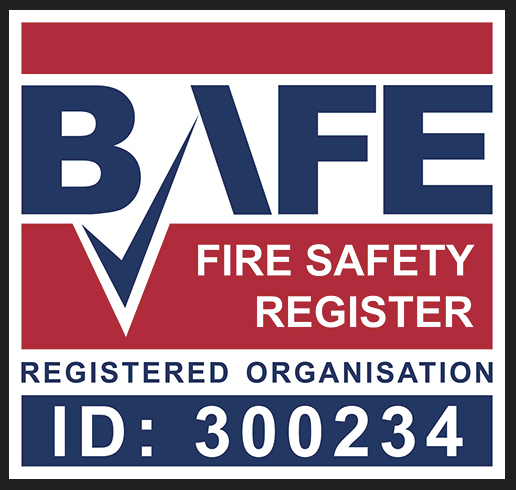Industry Articles
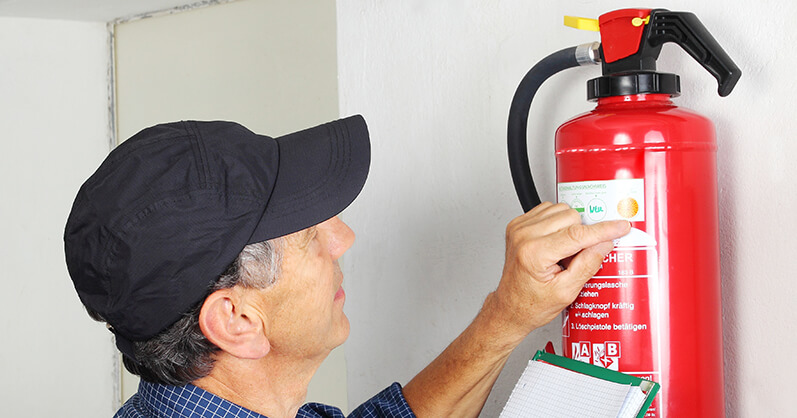
Fire Extinguisher Maintenance
Fire extinguishers have come a long way, and so have the rules and regulations surrounding them. The Regulatory Reform (Fire Safety) Order 2005 (RRO) outlines the need for a responsible person to take charge of all fire safety aspects, and that involves organising regular fire safety maintenance – including the regular servicing of fire extinguishers.
What is fire extinguisher maintenance?
Fire extinguisher maintenance is undertaken by a qualified engineer who will carry out a number of checks in order to establish if everything is in working order. Typical maintenance included in an annual service consists of the following:
- Carrying out a visual inspection.
- Checking the extinguisher has not been used or tampered with.
- Taking a pressure gauge reading.
- Removing the discharge hose to check for blockages or corrosion.
- Weigh and clean the extinguisher.
- Ensure wall mountings are secure.
Many problems can arise when clients receive poor service from their provider, or when things don’t make sense because they don’t understand the British Standards. Without a full understanding of the process, it is easy to see how things can get confusing and frustrating. At DFP we don’t expect you to be familiar with these things – we handle them all for you. We are happy to explain anything and even show our clients if it’s needed.
Ultimately, 99% reliability in your fire extinguishers is not good enough. You need to have complete peace of mind that in an emergency your extinguisher will function in the right way at the right time – regular maintenance ensures this.
How often should fire extinguisher maintenance be done?
According to the British Standard BS5306:3 (2017), it is recommended to carry out maintenance on your fire extinguishers once every year. However, if there is a drop in the pressure of the extinguishers, or if any damage is identified during the monthly visual inspection, then a basic service may need to be done more than once in a 12 month period. DFP customers can simply contact our qualified engineers and notify them of the issue that has been identified and arrange an inspection for the affected extinguisher.
Regardless of the type of extinguisher being used in your building, a monthly inspection will need to be conducted to check for any damage or pressure changes, and a basic service will need to be done once every year.
Every 5 years water, water-based and powder extinguishers will need to undergo a more detailed maintenance check, called an extended service. For primary sealed powder and CO2 extinguishers, an extended service is only required every 10 years.
If your organisation is currently using powder fire extinguishers, it is worth considering an alternative for indoor use where possible. When discharged, powder fire extinguishers make a lot of mess that can also potentially obstruct exit routes. There are plenty of other options available that are more effective. Our friendly team is always happy to help customers explore alternatives if needed.
With so much going on throughout the year, it can be hard to remember when annual servicing, or even extended servicing, is due. As part of our Fire Safety Maintenance service, we ensure this never happens by keeping a diary of all annual service dates so we can remind our customers when theirs is coming up.
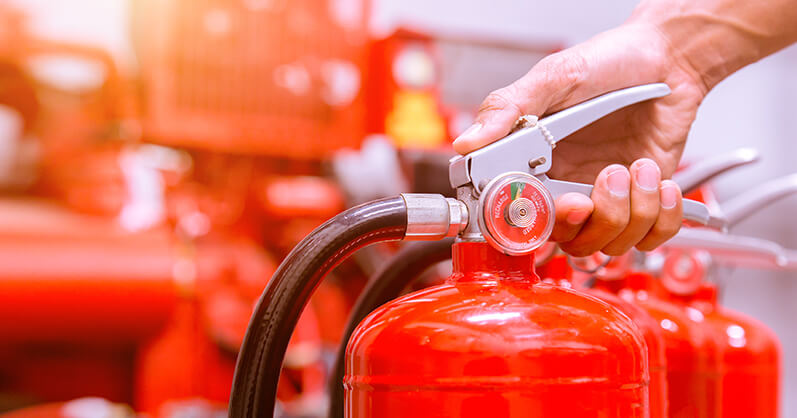
Who carries out fire extinguisher maintenance?
There is a common misconception that as an industry we come out, dust your extinguisher and sign the service label – but there is much more involved than that.
A monthly visual inspection will need to take place and is typically performed by the assigned responsible person (RP), requiring them to carry out and record a number of visual checks noted on the fire extinguisher checklist detailed later in this article.
A basic service is carried out annually by a qualified engineer so they can check for tampering, blockages, damage, and corrosion. This is extremely important as extinguishers can often be condemned due to corrosion and as rust occurs internally, this can only be noticed by a trained engineer during an annual check.
An extended service is carried out every 5 or 10 years depending on your extinguisher. BS 5306-3 requires that water, foam and powder extinguishers be discharged and refilled every 5 years, giving engineers an opportunity to check that it works ‘for real’, look inside the extinguishers for any internal defects, and renew the contents of the extinguisher.
CO2 extinguishers, being high-pressure vessels, require pressure testing and refilling every 10 years. In the case of both powders and CO2s, these tests cannot be performed on site, and so service exchange ‘overhauled’ extinguishers are installed, and the original extinguishers are taken away for testing. Sometimes it is beneficial to do the same for water and foam extinguishers as well.
Basic servicing and extended servicing must always be carried out by a qualified engineer as both processes involve a thorough inspection that will determine whether the fire extinguisher is unfit for use. Most engineers will be BAFE accredited, meaning they are competent in providing specific fire protection services.
As one of the leading fire protection providers in Dorset and the surrounding areas of the South, all of our engineers are third party examined and accredited by BAFE, meaning you can rely on us to carry out your fire extinguisher maintenance quickly and efficiently.
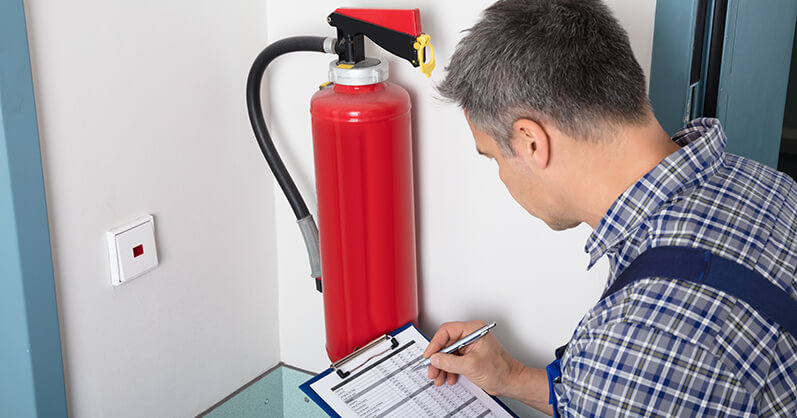
Fire extinguisher monthly inspection checklist
As explained, a monthly visual inspection is mandatory for all fire extinguishers and it can be carried out by anyone. With that in mind, it’s important for the assigned person to know what to look for. The best way to do this is by following a fire extinguisher maintenance checklist:
- Check the visibility and location of the fire extinguisher, making sure that they’re in a convenient, easy to reach place that doesn’t obstruct an exit and can be seen clearly.
- Inspect the condition of the extinguisher and make note of any obvious damage, leakage or corrosion.
- View the pressure gauge and make sure it is within safe operating limits.
- Examine the extinguisher for any signs of tampering, ensuring the tamper seal isn’t broken.
- Make sure the operating instructions are facing outwards and can be easily read.
- Check the date of the last basic service to check for the next annual maintenance and then record your monthly visual check.
If any problems are noticed during the visual check then it’s important to call an experienced engineer so they can perform a basic service to identify whether the extinguisher is still effective.
Learn more about monthly fire extinguisher checks in our video below.
CHECK OUT OUR OTHER VIDEO RESOURCES
How should different fire extinguishers be serviced?
There are four main types of extinguisher: water, foam, powder, and CO2. However, the way an extinguisher is serviced depends on the way it is operated, not the type of material it uses.
Extinguishers are operated in two ways:
- Stored Pressure: The pressurising gas is stored in the same cylinder as the extinguisher agent.
- Cartridge Operated: The extinguisher agent is kept in the main cylinder that is not pressurised while a separate cylinder contains pressurised CO2. Pressure will only be released into the main cylinder once the handle is squeezed, resulting in the CO2 cartridge being pierced.
Maintenance carried out for cartridge operated extinguishers is much more involved and can take more time than servicing stored pressure fire extinguishers. This is due to the fact that there are two cylinders to check as well as new head caps and discharge hoses needing to be fitted each time. There are very few cartridge operated extinguishers in the field nowadays.
We have helped a number of SMEs, schools, hotels, and a variety of other organisations in and around Dorset prepare for an unplanned emergency by providing the best fire extinguishers and the most efficient layout for your premises. We offer complete assurance with our BAFE qualified engineers and a 10-year guarantee.
How much does fire maintenance cost?
Traditional maintenance pricing could be compared to a car service – when you get it done you can’t be certain what the final cost will be, customers can be stung by nasty shocks such as unexpected spare parts added to the invoice. This can quickly become confusing.
This is often what happens with many companies but at DFP we have services in place so our customers can avoid this altogether. We maintain an open dialogue with all of our customers regarding upcoming expenses in order to help them avoid any unexpected costs.
This can all be overcome with our Comprehensive Maintenance programme which includes all spare parts as well as 5 and 10 yearly testing.
Why regular servicing is important
Regular maintenance of your fire extinguishers is not only incredibly important for fire protection, but it is required by both BS5306:3 2017 and the Regulatory Reform (Fire Safety) Order 2005.
Having a fire extinguisher on site is the first step to efficient fire safety, but it is not enough to just have one. Regular maintenance ensures that fire extinguishers are working efficiently and can be used effectively in the case of a fire emergency.
Whether you’re the facilities manager, part of the HR department or the individual responsible for fire safety in your organisation, we’ll work closely with you to provide high-quality maintenance, every time.
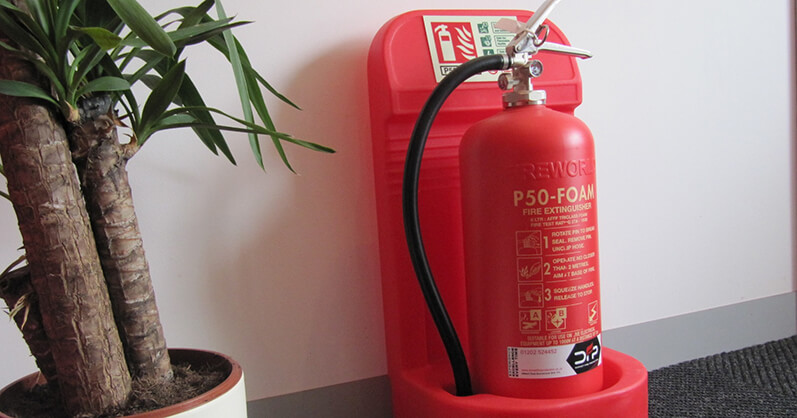
What is a self-service fire extinguisher?
Alternatively, you may be in a position to consider a self-service fire extinguisher. This revolutionary product is made from an ultra-tough composite material which cannot corrode, giving it a long life cycle of 20 years.
Due to this, only a simple visual inspection and a check of the gauge with a magnet is required, and these can be done by anyone, reducing the need for annual maintenance and cutting costs.
We’re happy to supply your business with self-service extinguishers. If you want to explore this option simply get in touch with our team for expert fire safety maintenance advice.
Summary
In the event of an emergency, can you be certain that your fire extinguishers will work? DFP can carry out regular fire safety maintenance on all extinguishers, giving you the assurance you need.
We strongly recommend a maintenance programme such as our Comprehensive Maintenance or Fixed-Fee Maintenance which helps our clients to budget more accurately for the annual maintenance.
If you’d like more information, feel free to contact us by phone on 0330 7000 555 or by email. We are located in the heart of Dorset, and are primed and ready to answer your calls Monday – Friday, 8am-4.30pm.
This article was written by Gary Askew, Managing Director of Dorset Fire Protection.
He has over 20 years experience of supplying fire prevention measures and finding premium solutions.

Follow Gary on LinkedIn
Follow DFP on LinkedIn
Follow DFP on Facebook



